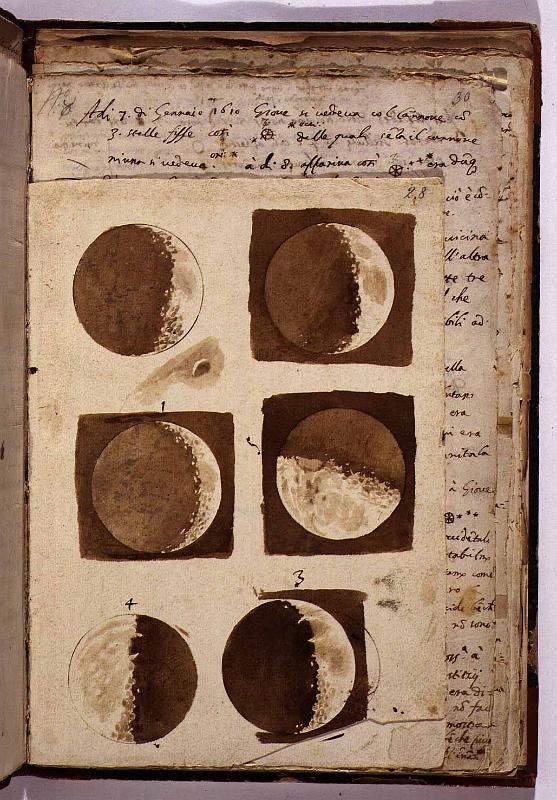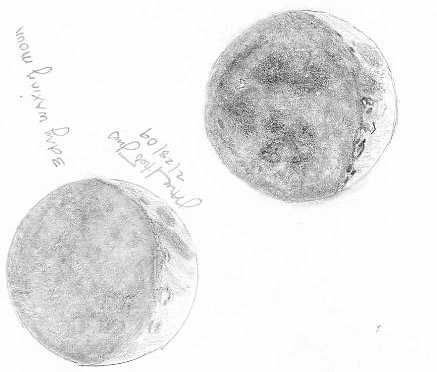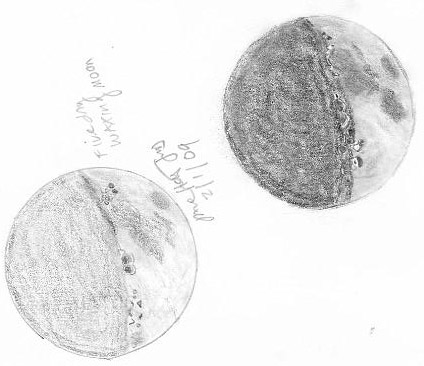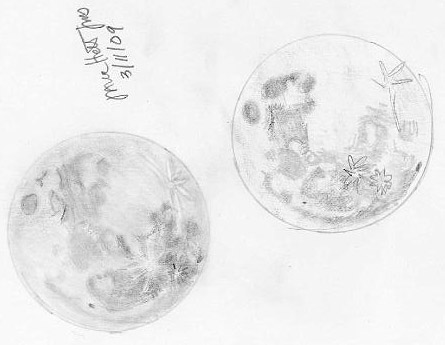Galileo’s watercolor drawings were made with brown ink wash on watercolor paper. To me, these are the most beautiful of Galileo’s astronomical renderings. When I look at the lunar terminator through my own telescopes, and hunt for interesting features to sketch, I sometime daydream, and try to imagine what Galileo thought as he surveyed these surprising lunar features. I feel a tingle every time I see the sunrise or the sunset illuminate a lunar crater floor, or escape through a crumbling wall to create a fleeting sun ray.
I’ve been sketching the moon for about 20 years, but I’ve always focused on a small segment of the lunar terminator as my sketching target. I’d never tried to sketch the entire moon in one sitting before. Sketching the entire lunar disk is a daunting project. So I decided to make my sketches very small – three sketches to a page. I like to show my “rough sketch” first. It is sort of a outline of the major features. Then I create a finer sketch, filling in the details. Often, I make a third “final final” sketch, too.
I used a 5″ x 8″ inch bound sketch book instead of my usual 3.5 x 5 inch 400 Series Strathmore spiral bound sketch pad. I always use my slender set of 12 mix and match Pitt pure graphite, Castell fine, and Wasserlack bold Faber-Castell graphite art set pencils. I like to keep the sketching process simple and uncluttered and the supplies compact. No table, no lights shining off my forehead, no messy products that would get on my Zeiss eyepieces or my fingers. Armed with these supplies, all I have to do is wait for the moon to become visible on a night of above-average seeing.
Here is a partial collection of “cropped” lunar sketch pages made at the eyepiece of my 70mm Televue f/7.8 Ranger refractor. I haven’t completed my “Galileo-like” lunar sketches yet because I prefer to wait for those nights of exceptional seeing to sketch at the eyepiece, and I am in no hurry to finish this project. These crops don’t show the “rough” sketch, and are rotated to match Galileo’s brown ink wash paintings. There is one full sketch linked at the bottom of this article, and I’ll dedicate one future blog to each of the lunar sketches.
I used one of the finest planetary eyepieces to complement my telescope — a 25mm Zeiss Abbe Orthoscopic. This gave me a 19x view of the lunar surface, similar to what you would see through a pair of binoculars, but also similar to the magnification (but not the same field of view) of Galileo’s telescope, which was 21x. Twentieth century Extra-Low Dispersion (“ED”) glass in the Televue Ranger and the exceptional quality of the Zeiss Abbe orthoscopic eyepieces plus a wider field of view give me quite an advantage, but that’s the telescope and eyepieces I have at my disposal. Lucky me!
An example of my uncropped 3-to-a-page lunar sketches through a 70mm refractor




Hi Jane,
Very nice website–great sketches by you (and G.)
Can you check your private messages on CN–I need to ask you a question about the podcast you did on Venus–more details in the PM.
Thanks,
Michael
Dear Jane,
I am writing a grant for a DVD of an imaginary meeting bet. Galileo and Shakespeare and I want to show how people all over the US are inspired by Galileo. Are you an astronomer by profession? Or are you in some other line of work as well?
Thanks,
Gloria McMillan
I am a long time 25 year astronomer by avocation (an amateur astronomer) but I also do work at NASA as an outreach (aka education) specialist. In my job I do a monthly podcast http://solarsystem.nasa.gov/news/whatsup.cfm and for each month in 2009 I have focused on Galileo’s first observations – this is because 2009 is International Year of astronomy celebrating Galileo’s first observations using a telescope in 1609. I’ve been an astronomical sketcher every since I made my first telescope in 1988, and for International Year of astronomy I am recreeating Galileo’s first sketches myself. Each of his sketches are in my podcasts too.